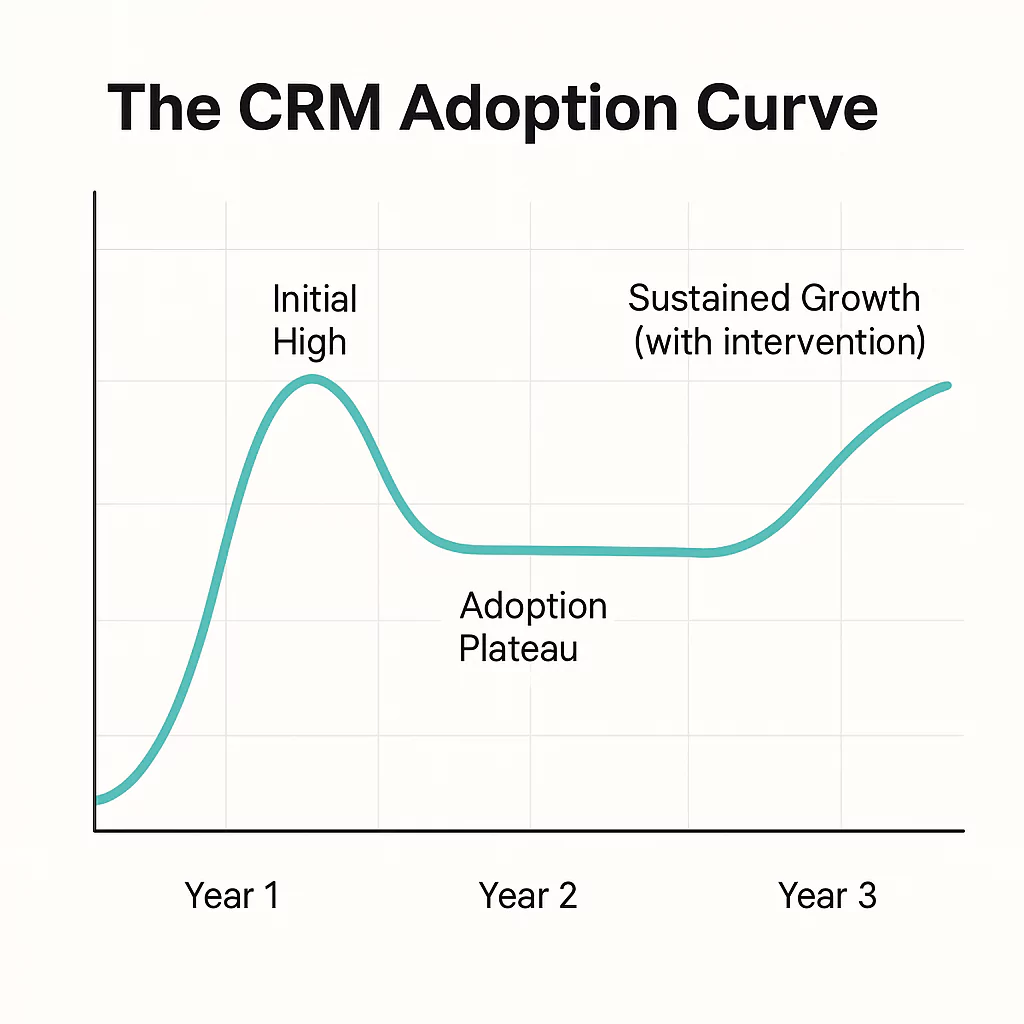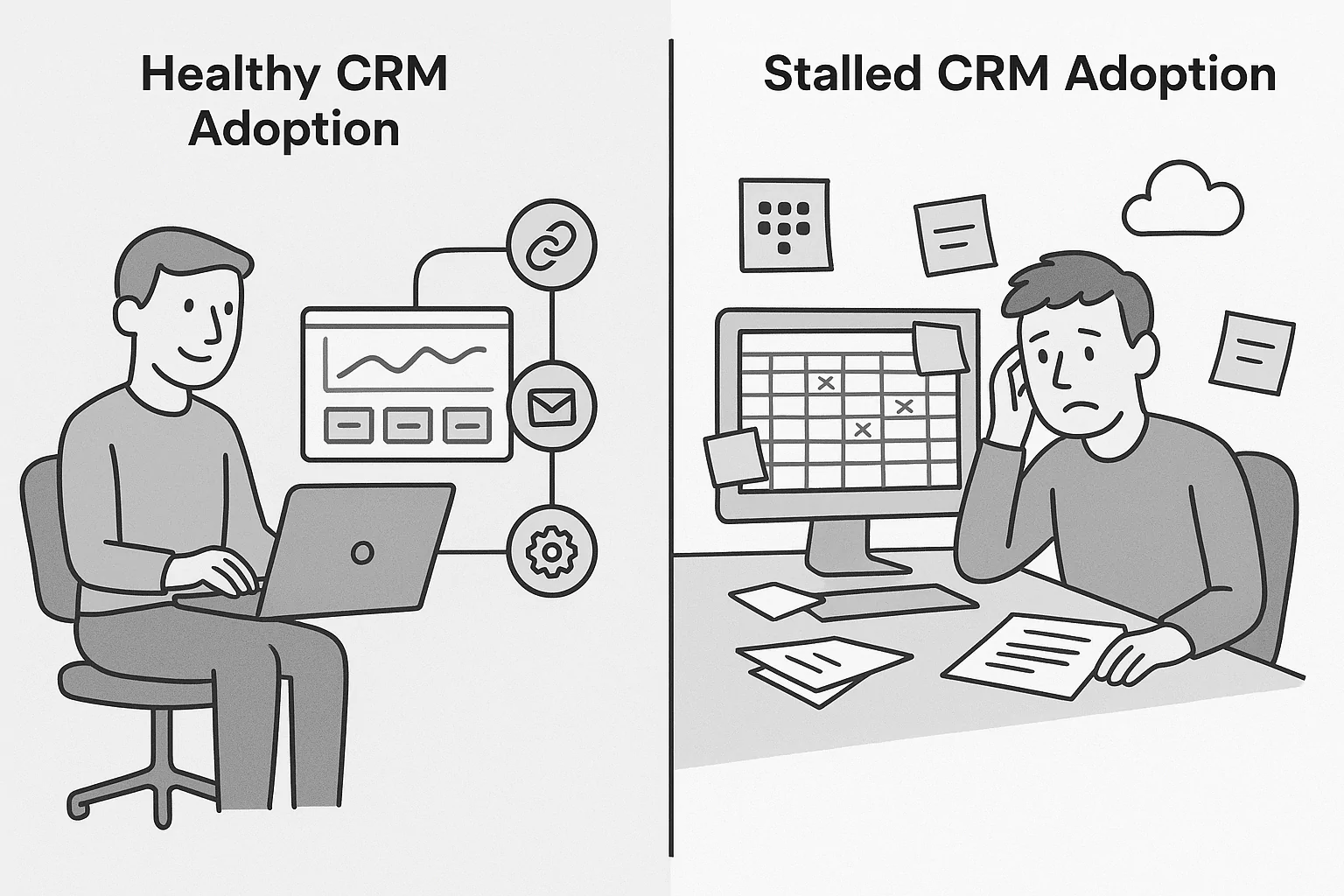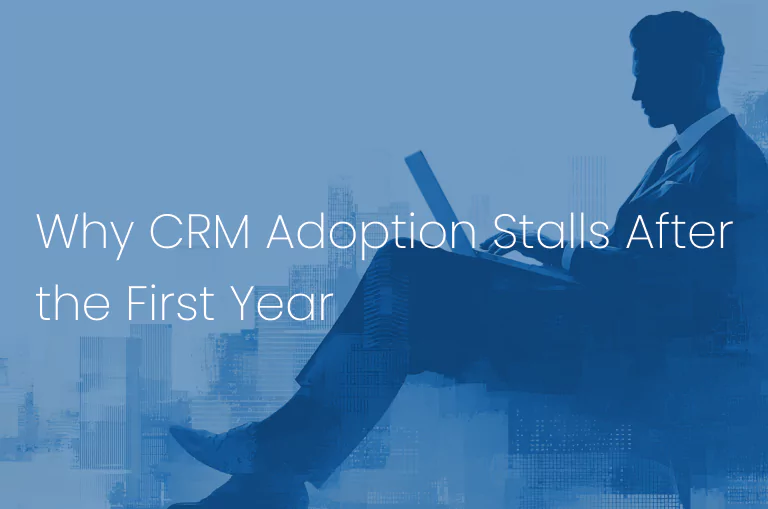Why CRM Adoption Stalls After the First Year
Introduction: The Promise vs. Reality of CRM
When a new CRM system goes live, the atmosphere is often electric. Teams are energised, leadership is vocal about the benefits, and early reports show improved visibility of customer interactions. Yet, after the initial surge of enthusiasm, many organisations encounter a slowdown. The system is still in place, but usage flattens, updates become inconsistent, and the excitement fades.
This “second-year slump” is a common experience across industries. Understanding why adoption loses momentum is essential for organisations that want to protect their investment and ensure that CRM becomes a long-term driver of growth, not just another piece of underused software.
The Initial High: Why Year One Looks Successful
The first year after CRM implementation is often marked by visible wins. Employees are introduced to a new system with training and clear direction, while management places strong emphasis on using the tool.
In many cases, early adoption metrics look promising: log-ins are high, sales teams enter pipeline data regularly, and dashboards are used to inform decisions. Leadership celebrates these numbers, seeing the CRM as a successful digital transformation initiative.
This initial success is supported by vendors showcasing case studies and highlighting feature sets. At this stage, enthusiasm can mask deeper challenges. What looks like genuine adoption may, in reality, be short-term compliance, with users following instructions but not fully integrating the CRM into their daily habits.
Why Momentum Slows After Year One
Once the first wave of energy fades, maintaining steady engagement becomes harder. By the second year, several challenges begin to surface.
Lack of sustained leadership engagement
Without ongoing sponsorship, CRM usage quickly shifts from being a strategic initiative to a background tool. If leaders no longer use dashboards in meetings or request CRM data in reports, employees lose motivation to update records.
Poor integration with daily work
If CRM systems are not seamlessly connected to email, ERP, or communication platforms, users see them as an extra burden.
User frustration
Sales and service teams often cite repetitive data entry, confusing interfaces, or limited mobile access as reasons for disengagement.
Misaligned success metrics
Many organisations measure CRM adoption by activity (log-ins, record creation) rather than outcomes (conversion rates, retention, forecasting accuracy). This leads to disillusionment when activity does not translate into visible business value.
Over time, these factors combine into what we at ARP Ideas often call the “adoption plateau” - where the system exists but delivers only a fraction of its potential.

The Hidden Costs of Stalled Adoption
When CRM adoption stalls, the impact goes beyond unused licences. The costs are often hidden but significant.
-
Erosion of trust in digital projects: If staff perceive CRM as another failed system, it undermines future transformation initiatives.
-
Data fragmentation: Employees return to spreadsheets, emails, or personal notes, creating silos and inconsistencies.
-
Reduced ROI: Licences, integrations, and consulting fees represent a major investment. A stalled CRM means that value is left on the table.
-
Missed opportunities: Without reliable CRM data, organisations struggle with forecasting, pipeline analysis, and customer insights.
Healthy adoption vs. stalled adoption
| Area | Healthy Adoption | Stalled Adoption |
|---|---|---|
| Data quality | Consistent, accurate, and centralised | Fragmented across spreadsheets and systems |
| Employee behaviour | System embedded into daily workflows | Minimal use, often bypassed |
| Business outcomes | Better forecasting, customer retention, sales lift | Limited insights, poor ROI |
| Leadership perception | Seen as a strategic enabler | Viewed as costly overhead |

Case Insight: Dynamics 365 CRM in Practice
At ARP Ideas, we worked with a mid-sized European services company that rolled out Microsoft Dynamics 365 CRM. In the first year, adoption looked strong: dashboards improved pipeline visibility, reports became more accurate, and managers praised the system.
By the second year, however, usage had slipped. Sales teams reverted to offline notes, managers complained about incomplete data, and adoption rates dropped. The company faced the risk of CRM being sidelined.
Our approach was to realign CRM usage with business outcomes. We introduced role-specific dashboards, automated repetitive tasks through Power Automate, and embedded AI-driven suggestions with Dynamics 365 Copilot. Within months, adoption rose as users saw the system reduce workload rather than add to it. The lesson was clear: sustained adoption requires continuous alignment with evolving business needs, not a one-time launch.
How to Sustain CRM Momentum Beyond Year One
Sustaining CRM adoption requires deliberate effort beyond the initial implementation.
-
Reframe success metrics
Move away from activity-based measures and instead track outcomes such as revenue growth, customer lifetime value, and forecast accuracy. -
Invest in continuous training
Instead of one-time onboarding, provide role-based, scenario-driven learning. Peer champions inside teams can help sustain engagement. -
Automate wherever possible
Tools like Power Automate and Dynamics 365 Copilot reduce manual data entry and help integrate CRM into daily processes. Automation turns CRM from a reporting tool into a productivity enabler. -
Regularly review and adapt
Dashboards and KPIs should evolve in tandem with business priorities. Quarterly reviews ensure the CRM stays relevant and valuable.
At ARP Ideas, we often remind clients that CRM adoption is a journey, not a destination. Organisations that invest in continuous improvement see higher ROI and stronger alignment between people, processes, and technology.
Looking Ahead: The Future of CRM Adoption
The adoption challenge persists, but the tools are continually evolving. AI assistants embedded into CRM platforms are already making systems easier to use by surfacing insights and reducing administrative effort. Microsoft Dynamics 365 Copilot, for instance, allows users to draft emails, summarise meetings, and generate forecasts directly within CRM.
Beyond AI, platforms like Microsoft Fabric are transforming how data flows across the organisation. By unifying data sources, CRM becomes a central point for customer intelligence rather than a standalone repository.
The future belongs to organisations that treat adoption as an ongoing strategic priority. Those who continually adapt, integrate, and evolve their CRM will be better positioned to respond to changing markets and customer expectations.
Key Takeaways
-
CRM adoption often falters after the first year due to cultural, technical, and leadership factors.
-
The costs of stalled adoption include data silos, wasted investment, and lost trust in digital transformation.
-
Real-world cases show that sustained adoption requires realignment with outcomes, automation, and continuous training.
-
AI and unified data platforms are reducing barriers and making CRM more central to business strategy.
-
ARP Ideas helps organisations unlock long-term CRM value through Dynamics 365, Power Platform, and adoption-focused consulting.
FAQ
Is CRM adoption mainly about user training?
Training is important, but adoption depends equally on leadership support, process integration, and cultural alignment.
How can ROI be measured after the first year?
Focus on business outcomes such as sales conversion rates, pipeline accuracy, and customer retention, rather than activity metrics.
Do AI features really improve adoption?
Yes. By automating repetitive tasks and delivering insights directly within the workflow, AI features reduce friction and help users see immediate value.
What if our CRM adoption has already stalled?
It is never too late. Organisations can re-energise usage by refreshing dashboards, introducing automation, and linking CRM to measurable business outcomes.
Conclusion and Next Step
The first year of CRM often feels like success, but the true test lies in sustaining adoption over time. By recognising why momentum slows and addressing the underlying challenges, organisations can turn CRM into a long-term driver of customer insight and operational excellence.
At ARP Ideas, we specialise in helping organisations maximise their investment in Microsoft Dynamics 365, Power Platform, and AI-enabled solutions. If your CRM adoption is stalling, now is the time to act.
Get in touch with our team to explore how we can help sustain your CRM journey.


